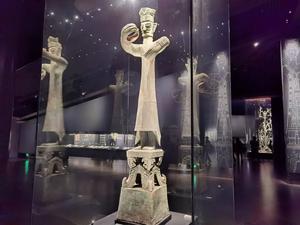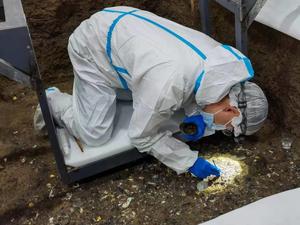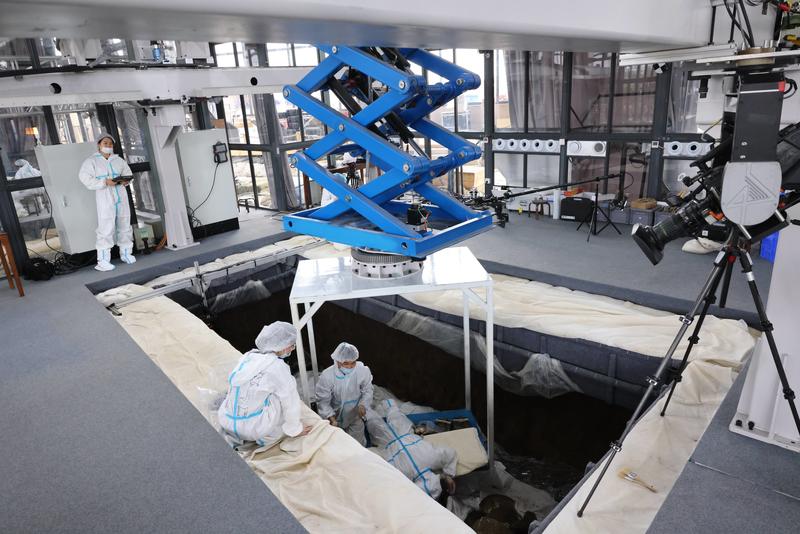 A 2.62-meterhigh bronze statue of a human figure excavated from Sanxingdui in 1986. (PHOTO PROVIDED TO CHINA DAILY)
A 2.62-meterhigh bronze statue of a human figure excavated from Sanxingdui in 1986. (PHOTO PROVIDED TO CHINA DAILY)
Anyone entering the archaeological site is required to wear a protective suit. No one is allowed to directly step on the surface of the excavation site to avoid any possible disturbance of the relics.
These are the strict rules governing the ongoing excavation of six freshly unearthed "sacrificial pits" that started in October at the Sanxingdui Ruins site in Guanghan, Sichuan province, which dates back more than three millennia.
Even for veteran archaeologist Chen Xiandan, 66, the experience of lying on an elevator to carefully approach the surface of the excavation site from above is new.
"This excavation may be a milestone in the history of Chinese archaeology in terms of new research methods and interdisciplinary studies," Chen says.
"It will greatly benefit our work on existing and future sites."
Chen is a former deputy director of Sichuan Provincial Cultural Relics and Archaeology Research Institute. He participated in the excavation of No 1 and 2 pits-presumably sacrificial in nature-in Sanxingdui in 1986, when over 1,000 artifacts were found, unveiling a brilliant bronze-civilization.
When recalling the excavation back then, Chen says he has regrets.
No 1 and 2 pits were accidentally found by farmers who had dug the soil there to make bricks.
Archaeologists had a race against time to rescue the relics from the pits within two months, and many artifacts were hastily processed.
Now, 3D printing technology is being used to make protective shields for the unearthed relics in the newly found pits.
"We have a much stronger squad now," Chen says.
Experts from 34 universities and research institutes nationwide have joined the ongoing excavation. According to Chen, even some firefighters have been invited to analyze the discovery of burn marks, helping to figure out how high the temperature was, which may offer a clue to possible ways in which sacrifices were carried out.
 An archaeologist takes samples from the newly found No 5"sacrificial pit" on March 19. (PHOTO PROVIDED TO CHINA DAILY)
An archaeologist takes samples from the newly found No 5"sacrificial pit" on March 19. (PHOTO PROVIDED TO CHINA DAILY)
Only a few meters away from the previous two pits, the newly found six pits are so close, yet were so far from the spotlight. They were almost entirely covered by tourist facilities, where visitors could get a closer view of the 1986 excavation site.
Archaeologists researched the area around No 1 and 2 pits again in 2019. Fortunately, a corner of No 3 pit was exposed. All tourist facilities were immediately removed for the new round of digs, and five more pits were found in 2020.
From August to October, four glass-andiron structures covering the pits, known as "excavation capsules", were set up.
To offer a suitable environment for the unearthed relics, the temperature around the pits has been kept between 20 and 25 C, and the humidity is maintained at 80 percent. The level of carbon dioxide inside the capsules is also being closely monitored.
No such facilities have been used in previous archaeological excavations in China.
A structure provides an extra protection for these capsules in case of bad weather. Seen from outside, the excavation site looks like a high-speed train station.
Also, for the first time in China, laboratories have been set up at the site to enable real-time conservation of unearthed relics and the analysis of findings.
"It's like an emergency hospital for the relics," says Wang Chong, a cultural relic conservator working on the site.
"They are comprehensively tested and we decide to which department they should go... These technologies have been used in our work for some time, but we never gathered all the facilities on the front line of archaeology before."
Eight high-definition web cameras have been placed on-site. Chen says they are connected with other experts via the cloud in case further consultation is needed.
 Archaeologists work in an "excavation capsule", which is equipped with advanced technology, at Sanxingdui Ruins in Guanghan, Sichuan province. (PHOTO PROVIDED TO CHINA DAILY)
Archaeologists work in an "excavation capsule", which is equipped with advanced technology, at Sanxingdui Ruins in Guanghan, Sichuan province. (PHOTO PROVIDED TO CHINA DAILY)
In 1986, the focus was on the artifacts found, but new developments in archaeology have now made it possible to take care of the soil dug up during the excavation of the pits.
"The soil is also considered as a cultural relic now," says Ran Honglin, a leading archaeologist at the ongoing excavation.
"By categorizing it in detail, we want to collect and record information as comprehensively as possible like building up a library. Researchers in our future generations can also benefit from our work."
Some findings in the soil have surfaced despite the relatively short time. For example, fibroin was discovered within a tiny soil sample, and a fabric pattern appeared in the lens of a microscope, indicating the use of silk in sacrifices.
Finding the time period of relics has been a question for researchers at the Sanxingdui ruins as radiocarbon dating results of artifacts unearthed from No 1 and 2 pits varied greatly in the past. Nevertheless, compared with purely relying on the artifacts, the soil provides a larger and more reliable sample to be studied.
A report by China Central Television on Tuesday said, according to the newest radiocarbon dating, based on samples of carbon dust collected from the soil of No 4 pit, it might date back to between 1199 and 1017 BC.
"Do all the six pits belong to the same period? Dating results will help us to understand their function and significance better," says Sun Hua, a professor at Peking University.
The development of new technology will help. For example, how to preserve more than 100 ivory tusks that have been found during the ongoing excavation.
"Conservation of ivory is a problem commonly faced by archaeologists worldwide," says Wang Yi, director of Sichuan Provincial Cultural Heritage Administration. "We're exploring, and a cautious attitude is needed before adopting new methods."


